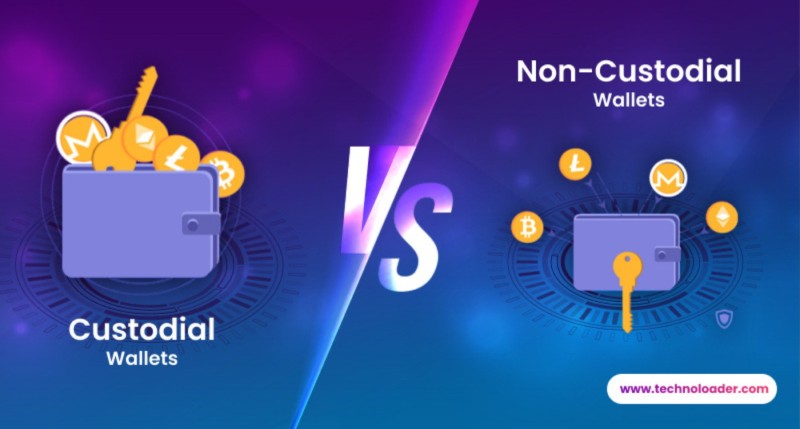The adoption of cryptocurrency wallets is on the rise, fueled by the increasing acceptance of digital currencies and blockchain technology. As more businesses and individuals engage in crypto trading and decentralized finance (DeFi), understanding the different types of wallets becomes crucial.
For developers and businesses, choosing the right type of wallet whether custodial or non-custodial can significantly influence the user experience, security measures, and compliance requirements.
In this blog, we will explore the key differences between custodial and non-custodial wallets and break down the development challenges and considerations for each.
What Are Custodial Wallets?
Custodial wallets are crypto wallets in which a third party (usually a platform or exchange) holds the user's private keys. This means that the platform is responsible for managing the funds, ensuring security, and performing other administrative functions such as backup and recovery.
Users trust the service provider to maintain the safety of their assets, and they can access their funds through the platform’s interface.
Common examples of custodial wallets include those provided by centralized exchanges such as Binance, Coinbase, or Kraken. These wallets allow users to easily access and trade cryptocurrencies, but they also come with certain risks, primarily around the potential vulnerabilities of centralized control.
What Are Non-Custodial Wallets?
Non-custodial wallets, on the other hand, give users full control over their private keys and, ultimately, their funds. The private keys are stored locally on the user's device, and only the user has access to them.
Since there is no third party involved in the management of funds, non-custodial wallets are typically more secure in terms of user autonomy and privacy.
Popular examples of non-custodial wallets include MetaMask, Trust Wallet, and hardware wallets like Ledger. These wallets are essential to decentralized applications (dApps) and DeFi, where users interact directly with smart contracts and decentralized networks without the need for an intermediary.
Custodial vs Non-Custodial: Key Development Differences
|
Aspect |
Custodial Wallets |
Non-Custodial Wallets |
|
Private Key Storage & Security |
Keys are stored and managed by the service provider, adding convenience but also risk. |
User controls the private keys directly, providing better privacy and security. |
|
Backend Architecture |
Built on centralized infrastructure that stores user data and assets. |
Built on blockchain or decentralized networks with no central server. |
|
User Control Over Funds |
Platform controls the funds, requiring trust in the provider. |
User has full control, making it more autonomous but also more responsibility. |
|
Compliance & KYC Requirements |
Typically requires KYC/AML compliance to meet regulatory standards. |
Generally doesn’t require KYC, aligning with the principles of DeFi and anonymity. |
|
Infrastructure & Hosting |
Centralized server setup and database for asset management. |
Decentralized architecture, often relying on blockchain and dApp infrastructure. |
|
Recovery & Backup Mechanisms |
Centralized backup systems for recovering funds. |
Uses seed phrases or social recovery methods, putting responsibility on the user. |
|
Transaction Handling |
Transactions are manually signed by the platform, often through an API or platform interface. |
Transactions are signed by the user’s private key, often through smart contracts. |
|
Smart Contract Integration |
Rarely integrates with smart contracts unless the wallet is connected to a dApp. |
Smart contract-based wallets are essential for DeFi interaction and dApp use. |
Development Tools and Technology Stack
The development of custodial and non-custodial wallets involves different technical tools and stacks, and choosing the right crypto wallet development solution is essential to meet the respective needs of each type:
1. Blockchain APIs
- Web3.js: A JavaScript library that allows developers to interact with the Ethereum blockchain. It is commonly used in non-custodial wallet development.
- Ethers.js: A JavaScript library for interacting with the Ethereum blockchain, similar to Web3.js, with a focus on simplicity and security
2. Multi-Signature Wallet Integration
- Multi-signature wallets require multiple private keys for transaction approval, enhancing security.
- Integration for both custodial and non-custodial wallets can involve the use of services like Gnosis Safe for decentralized applications or multi-sig smart contracts.
3. Wallet SDKs for Custodial and Non-Custodial Platforms
- Custodial wallet SDKs focus on facilitating secure, scalable wallets that are easy to integrate with centralized exchanges.
- Non-custodial wallet SDKs, such as MetaMask SDK or WalletConnect, allow users to connect directly with dApps and blockchain networks.
4. Mobile and Web3 Wallet Integration Options
- Mobile integration tools are essential for both custodial and non-custodial wallets, ensuring users can manage their wallets seamlessly across platforms.
- Web3 integration allows for smooth interactions between decentralized applications (dApps) and non-custodial wallets.
Security Considerations in Custodial Vs Non-Custodial Wallets
Hot vs Cold Wallets
- Hot Wallets: These wallets are connected to the internet and are typically used for daily transactions. They are more vulnerable to hacks but are necessary for quick access to funds.
- Cold Wallets: These are offline storage solutions (like hardware wallets) and are far more secure against hacking, making them ideal for long-term storage.
Common Vulnerabilities and Protection Measures
- Custodial Wallets: Vulnerable to exchange hacks and insider threats. Protection measures include two-factor authentication (2FA), multi-sig, and strong encryption.
- Non-Custodial Wallets: Although more secure from centralized hacks, non-custodial wallets can be vulnerable to phishing attacks and device theft. Protection measures include hardware wallets, password managers, and cold storage.
Security Audits for Smart Contract-Based Wallets
- Smart contract wallets, used in non-custodial systems, require regular security audits to identify vulnerabilities in the code.
- Developers often use tools like MythX or Certik to audit smart contracts for bugs and potential security issues.
Use Cases and Industry Applications
Crypto Exchanges (Custodial Wallets)
Custodial wallets are integral to centralized crypto exchanges where the platform takes responsibility for managing users' funds. This makes it easier for exchanges to offer a smooth trading experience with features like instant deposits, withdrawals, and user support.
DeFi Apps (Non-Custodial Wallets)
Non-custodial wallets are essential in decentralized finance (DeFi) applications. They provide users with the ability to interact with smart contracts, yield farming, lending protocols, and more, without a middleman.
NFT Platforms, Gaming Wallets, Payment Systems
- NFT Platforms: Non-custodial wallets are used to securely store NFTs and interact with the platforms.
- Gaming Wallets: Players in blockchain-based games use non-custodial wallets to store in-game assets and tokens.
- Payment Systems: Both custodial and non-custodial wallets can be used for handling cryptocurrency payments, depending on whether users want control or prefer convenience.
Businesses must evaluate their project goals when selecting between custodial or non-custodial wallets. Custodial wallets suit centralized businesses that require user convenience and control. Non-custodial wallets align with projects that prioritize decentralization and user privacy.
Conclusion
The differences between custodial and non-custodial wallets are profound, impacting not only the user experience but also the development process.
Custodial wallets, offering user convenience and centralized control, are suited for centralized exchanges and businesses that prioritize customer support and regulatory compliance.
Non-custodial wallets, in contrast, offer users autonomy, security, and privacy, making them perfect for DeFi applications, NFTs, and other decentralized platforms.
From a cryptocurrency wallet development perspective, custodial wallets require a centralized infrastructure with strong compliance and security measures, while non-custodial wallets leverage blockchain and smart contract technology, focusing on decentralization and user control.
Ultimately, the decision to develop a custodial or non-custodial wallet with Technoloader will align with your project’s long-term goals, target audience, and security requirements.
FAQs
1. What is a safer, custodial or non-custodial wallet?
Non-custodial wallets are generally safer as users control their private keys, reducing the risks associated with third-party breaches. However, custodial wallets can offer enhanced security with advanced infrastructure.
2. Can I switch from custodial to non-custodial wallet?
Yes, you can transfer your funds from a custodial wallet to a non-custodial wallet by withdrawing them to a private address.
3. Do non-custodial wallets support all tokens?
Most non-custodial wallets support popular tokens like Bitcoin and Ethereum, but support for tokens may vary depending on the wallet and its network compatibility.


